Leadership in Education: Ecological Theory and School Choice
VerifiedAdded on 2023/05/30
|6
|1312
|236
Essay
AI Summary
This essay delves into the application of ecological theory within the realm of education, primarily focusing on its influence on leadership and school choice. The essay begins by defining ecological theory, drawing on Davies' (2018) lecture notes, and explores how organizational performance and survival are affected by internal and external processes. It examines Davies and Quirke's (2007) research on Toronto schools, highlighting the factors shaping school choice, such as differentiation, flexibility, and niche creation, with public, private, and new-sector schools. Furthermore, the essay discusses Clark, Trick, and Van Loon's (2011) perspective on reforms in Ontario's higher education system, emphasizing the need for differentiation to address isomorphism. It also considers Milian, Davies, and Zarifa's (2016) analysis of barriers to differentiation, including ceremonial compliance and status seeking, and the role of for-profit universities in promoting differentiation. The essay integrates various sources to provide a comprehensive understanding of the complex interplay between ecological theory, leadership, and the evolving landscape of education.
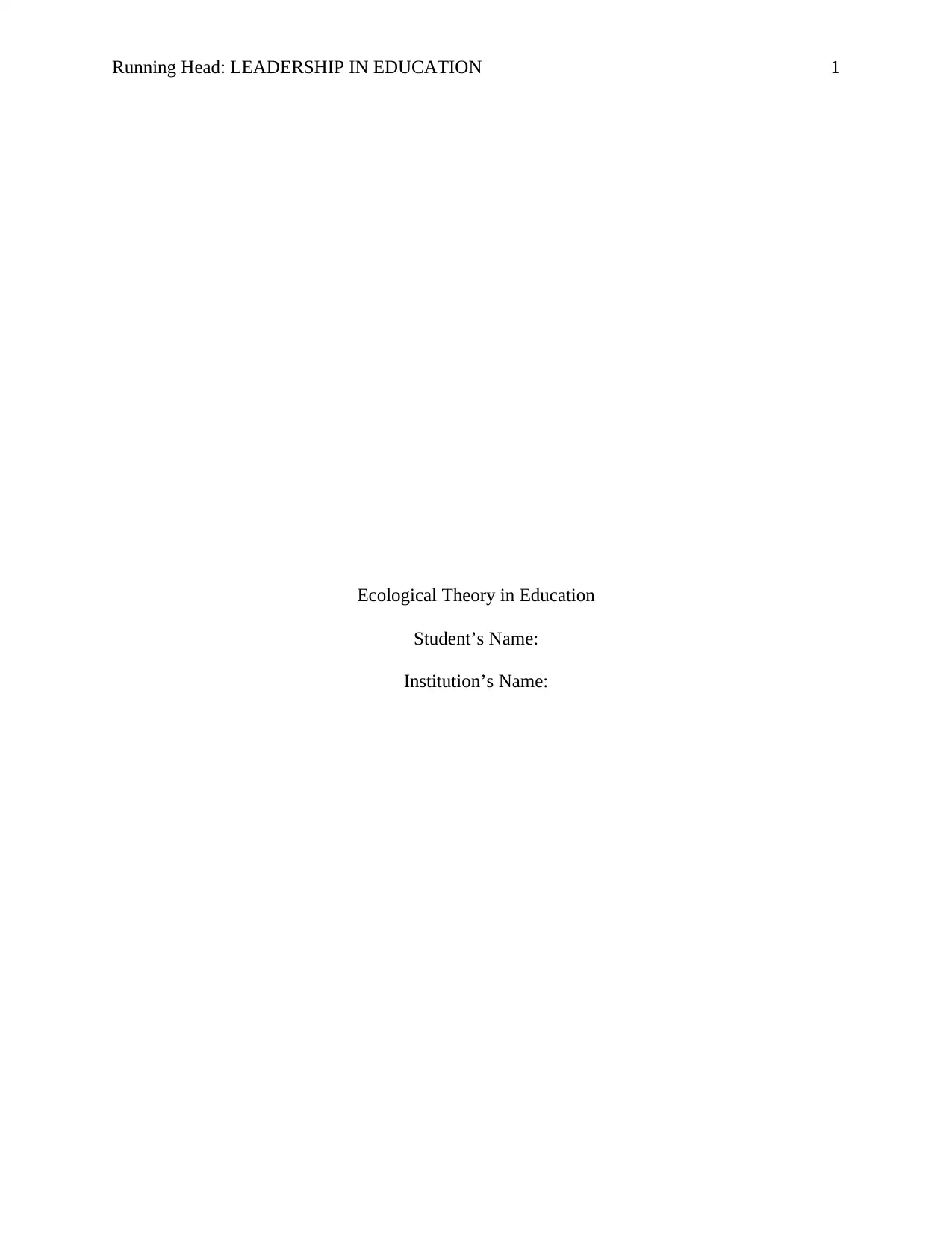
Running Head: LEADERSHIP IN EDUCATION 1
Ecological Theory in Education
Student’s Name:
Institution’s Name:
Ecological Theory in Education
Student’s Name:
Institution’s Name:
Paraphrase This Document
Need a fresh take? Get an instant paraphrase of this document with our AI Paraphraser
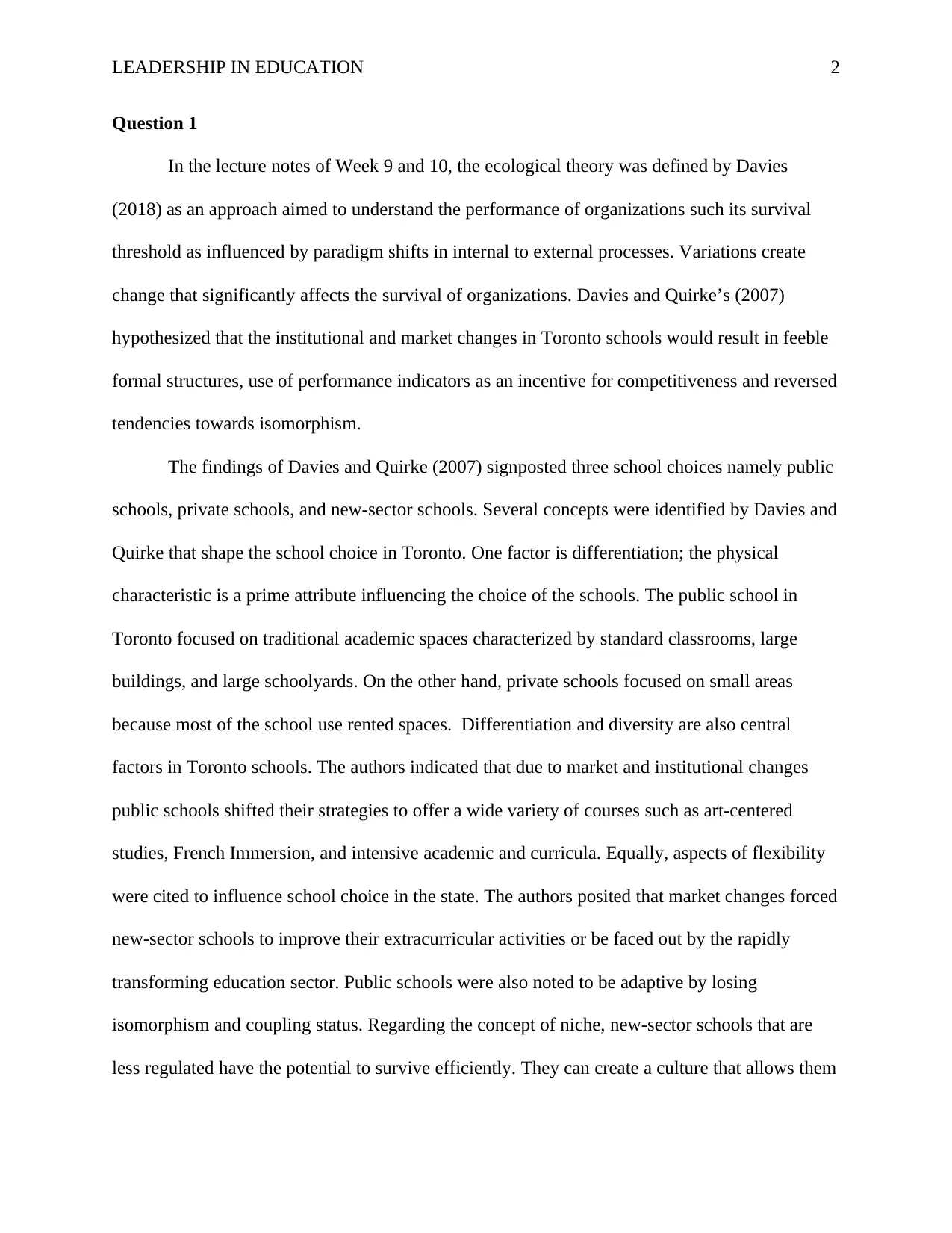
LEADERSHIP IN EDUCATION 2
Question 1
In the lecture notes of Week 9 and 10, the ecological theory was defined by Davies
(2018) as an approach aimed to understand the performance of organizations such its survival
threshold as influenced by paradigm shifts in internal to external processes. Variations create
change that significantly affects the survival of organizations. Davies and Quirke’s (2007)
hypothesized that the institutional and market changes in Toronto schools would result in feeble
formal structures, use of performance indicators as an incentive for competitiveness and reversed
tendencies towards isomorphism.
The findings of Davies and Quirke (2007) signposted three school choices namely public
schools, private schools, and new-sector schools. Several concepts were identified by Davies and
Quirke that shape the school choice in Toronto. One factor is differentiation; the physical
characteristic is a prime attribute influencing the choice of the schools. The public school in
Toronto focused on traditional academic spaces characterized by standard classrooms, large
buildings, and large schoolyards. On the other hand, private schools focused on small areas
because most of the school use rented spaces. Differentiation and diversity are also central
factors in Toronto schools. The authors indicated that due to market and institutional changes
public schools shifted their strategies to offer a wide variety of courses such as art-centered
studies, French Immersion, and intensive academic and curricula. Equally, aspects of flexibility
were cited to influence school choice in the state. The authors posited that market changes forced
new-sector schools to improve their extracurricular activities or be faced out by the rapidly
transforming education sector. Public schools were also noted to be adaptive by losing
isomorphism and coupling status. Regarding the concept of niche, new-sector schools that are
less regulated have the potential to survive efficiently. They can create a culture that allows them
Question 1
In the lecture notes of Week 9 and 10, the ecological theory was defined by Davies
(2018) as an approach aimed to understand the performance of organizations such its survival
threshold as influenced by paradigm shifts in internal to external processes. Variations create
change that significantly affects the survival of organizations. Davies and Quirke’s (2007)
hypothesized that the institutional and market changes in Toronto schools would result in feeble
formal structures, use of performance indicators as an incentive for competitiveness and reversed
tendencies towards isomorphism.
The findings of Davies and Quirke (2007) signposted three school choices namely public
schools, private schools, and new-sector schools. Several concepts were identified by Davies and
Quirke that shape the school choice in Toronto. One factor is differentiation; the physical
characteristic is a prime attribute influencing the choice of the schools. The public school in
Toronto focused on traditional academic spaces characterized by standard classrooms, large
buildings, and large schoolyards. On the other hand, private schools focused on small areas
because most of the school use rented spaces. Differentiation and diversity are also central
factors in Toronto schools. The authors indicated that due to market and institutional changes
public schools shifted their strategies to offer a wide variety of courses such as art-centered
studies, French Immersion, and intensive academic and curricula. Equally, aspects of flexibility
were cited to influence school choice in the state. The authors posited that market changes forced
new-sector schools to improve their extracurricular activities or be faced out by the rapidly
transforming education sector. Public schools were also noted to be adaptive by losing
isomorphism and coupling status. Regarding the concept of niche, new-sector schools that are
less regulated have the potential to survive efficiently. They can create a culture that allows them
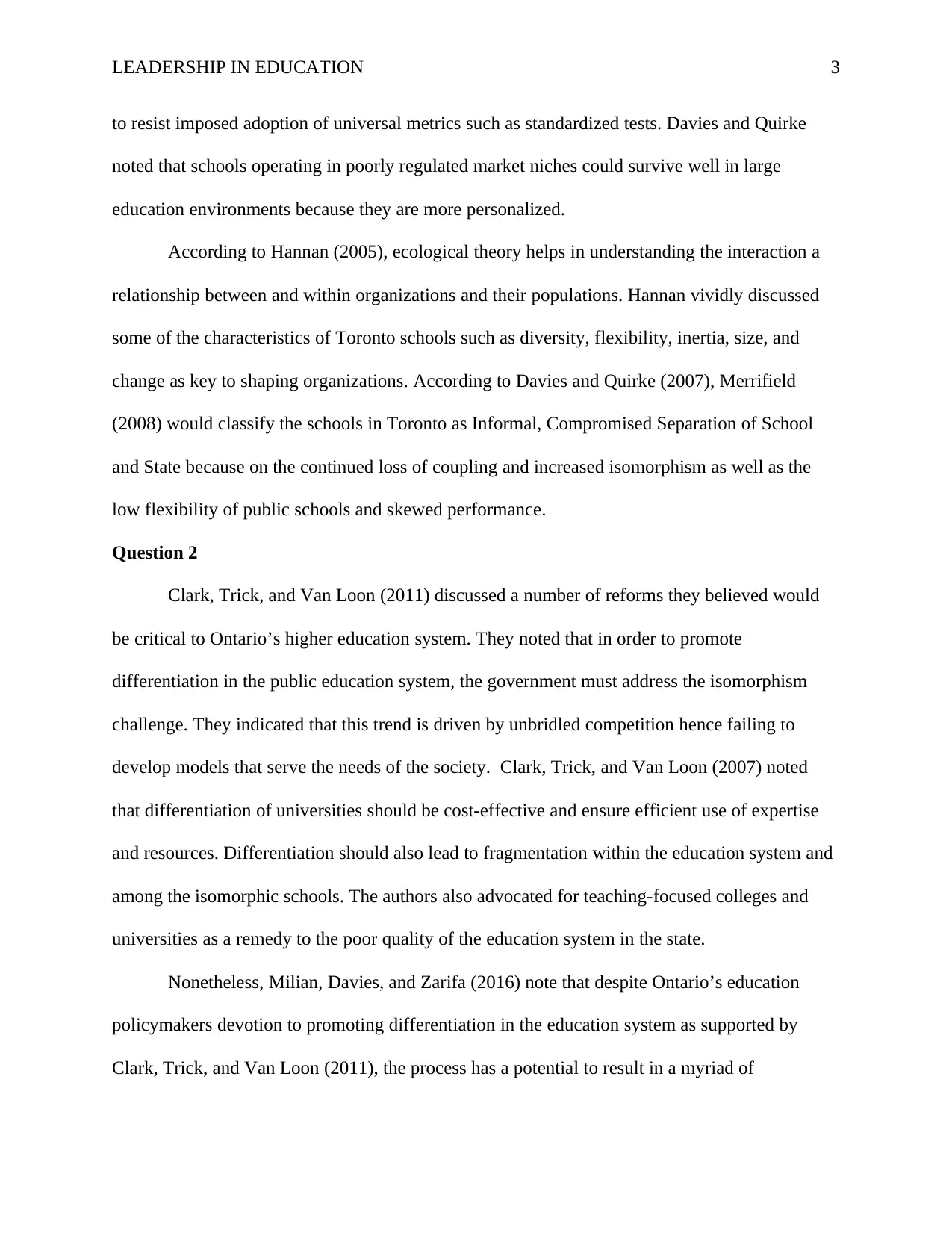
LEADERSHIP IN EDUCATION 3
to resist imposed adoption of universal metrics such as standardized tests. Davies and Quirke
noted that schools operating in poorly regulated market niches could survive well in large
education environments because they are more personalized.
According to Hannan (2005), ecological theory helps in understanding the interaction a
relationship between and within organizations and their populations. Hannan vividly discussed
some of the characteristics of Toronto schools such as diversity, flexibility, inertia, size, and
change as key to shaping organizations. According to Davies and Quirke (2007), Merrifield
(2008) would classify the schools in Toronto as Informal, Compromised Separation of School
and State because on the continued loss of coupling and increased isomorphism as well as the
low flexibility of public schools and skewed performance.
Question 2
Clark, Trick, and Van Loon (2011) discussed a number of reforms they believed would
be critical to Ontario’s higher education system. They noted that in order to promote
differentiation in the public education system, the government must address the isomorphism
challenge. They indicated that this trend is driven by unbridled competition hence failing to
develop models that serve the needs of the society. Clark, Trick, and Van Loon (2007) noted
that differentiation of universities should be cost-effective and ensure efficient use of expertise
and resources. Differentiation should also lead to fragmentation within the education system and
among the isomorphic schools. The authors also advocated for teaching-focused colleges and
universities as a remedy to the poor quality of the education system in the state.
Nonetheless, Milian, Davies, and Zarifa (2016) note that despite Ontario’s education
policymakers devotion to promoting differentiation in the education system as supported by
Clark, Trick, and Van Loon (2011), the process has a potential to result in a myriad of
to resist imposed adoption of universal metrics such as standardized tests. Davies and Quirke
noted that schools operating in poorly regulated market niches could survive well in large
education environments because they are more personalized.
According to Hannan (2005), ecological theory helps in understanding the interaction a
relationship between and within organizations and their populations. Hannan vividly discussed
some of the characteristics of Toronto schools such as diversity, flexibility, inertia, size, and
change as key to shaping organizations. According to Davies and Quirke (2007), Merrifield
(2008) would classify the schools in Toronto as Informal, Compromised Separation of School
and State because on the continued loss of coupling and increased isomorphism as well as the
low flexibility of public schools and skewed performance.
Question 2
Clark, Trick, and Van Loon (2011) discussed a number of reforms they believed would
be critical to Ontario’s higher education system. They noted that in order to promote
differentiation in the public education system, the government must address the isomorphism
challenge. They indicated that this trend is driven by unbridled competition hence failing to
develop models that serve the needs of the society. Clark, Trick, and Van Loon (2007) noted
that differentiation of universities should be cost-effective and ensure efficient use of expertise
and resources. Differentiation should also lead to fragmentation within the education system and
among the isomorphic schools. The authors also advocated for teaching-focused colleges and
universities as a remedy to the poor quality of the education system in the state.
Nonetheless, Milian, Davies, and Zarifa (2016) note that despite Ontario’s education
policymakers devotion to promoting differentiation in the education system as supported by
Clark, Trick, and Van Loon (2011), the process has a potential to result in a myriad of
⊘ This is a preview!⊘
Do you want full access?
Subscribe today to unlock all pages.

Trusted by 1+ million students worldwide
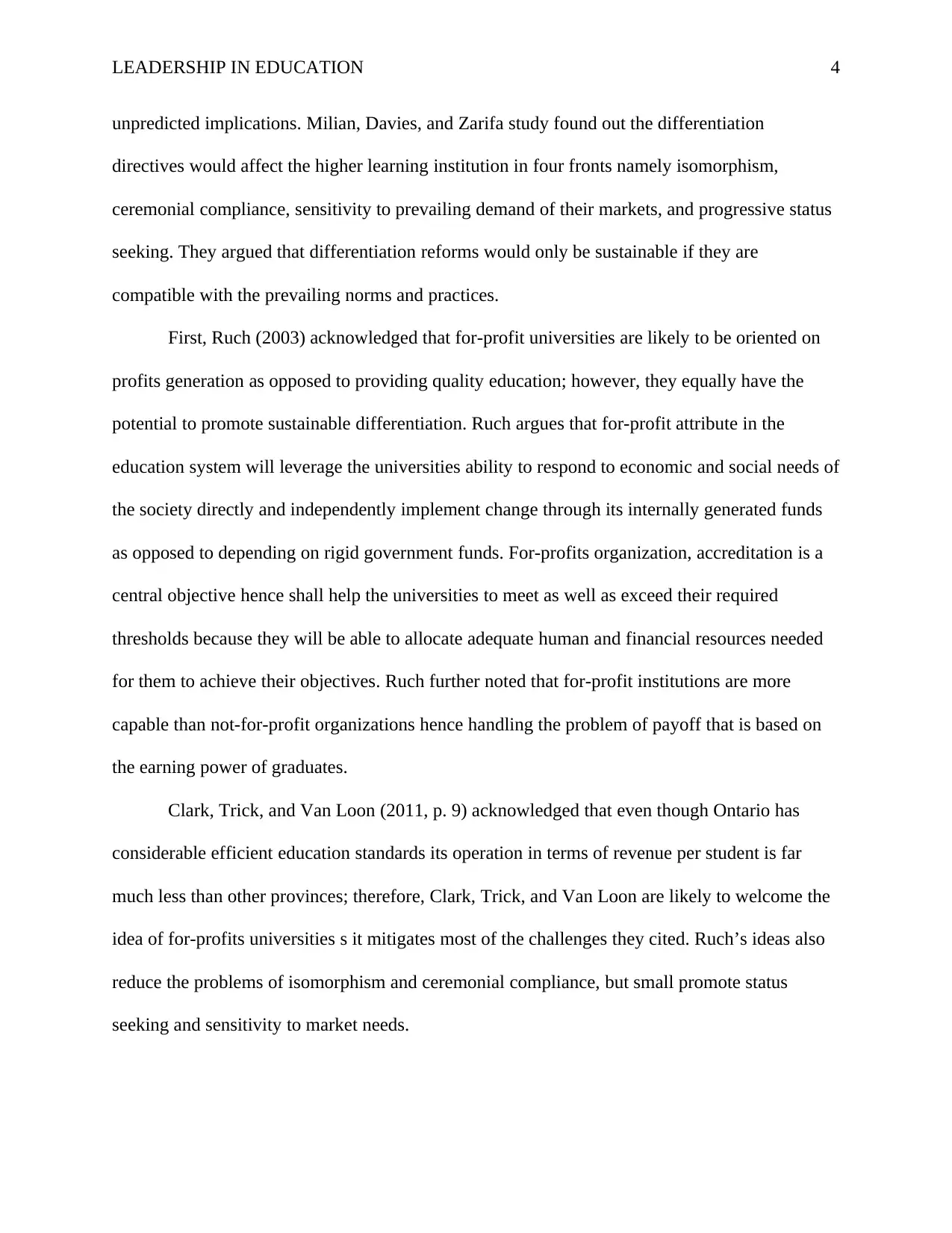
LEADERSHIP IN EDUCATION 4
unpredicted implications. Milian, Davies, and Zarifa study found out the differentiation
directives would affect the higher learning institution in four fronts namely isomorphism,
ceremonial compliance, sensitivity to prevailing demand of their markets, and progressive status
seeking. They argued that differentiation reforms would only be sustainable if they are
compatible with the prevailing norms and practices.
First, Ruch (2003) acknowledged that for-profit universities are likely to be oriented on
profits generation as opposed to providing quality education; however, they equally have the
potential to promote sustainable differentiation. Ruch argues that for-profit attribute in the
education system will leverage the universities ability to respond to economic and social needs of
the society directly and independently implement change through its internally generated funds
as opposed to depending on rigid government funds. For-profits organization, accreditation is a
central objective hence shall help the universities to meet as well as exceed their required
thresholds because they will be able to allocate adequate human and financial resources needed
for them to achieve their objectives. Ruch further noted that for-profit institutions are more
capable than not-for-profit organizations hence handling the problem of payoff that is based on
the earning power of graduates.
Clark, Trick, and Van Loon (2011, p. 9) acknowledged that even though Ontario has
considerable efficient education standards its operation in terms of revenue per student is far
much less than other provinces; therefore, Clark, Trick, and Van Loon are likely to welcome the
idea of for-profits universities s it mitigates most of the challenges they cited. Ruch’s ideas also
reduce the problems of isomorphism and ceremonial compliance, but small promote status
seeking and sensitivity to market needs.
unpredicted implications. Milian, Davies, and Zarifa study found out the differentiation
directives would affect the higher learning institution in four fronts namely isomorphism,
ceremonial compliance, sensitivity to prevailing demand of their markets, and progressive status
seeking. They argued that differentiation reforms would only be sustainable if they are
compatible with the prevailing norms and practices.
First, Ruch (2003) acknowledged that for-profit universities are likely to be oriented on
profits generation as opposed to providing quality education; however, they equally have the
potential to promote sustainable differentiation. Ruch argues that for-profit attribute in the
education system will leverage the universities ability to respond to economic and social needs of
the society directly and independently implement change through its internally generated funds
as opposed to depending on rigid government funds. For-profits organization, accreditation is a
central objective hence shall help the universities to meet as well as exceed their required
thresholds because they will be able to allocate adequate human and financial resources needed
for them to achieve their objectives. Ruch further noted that for-profit institutions are more
capable than not-for-profit organizations hence handling the problem of payoff that is based on
the earning power of graduates.
Clark, Trick, and Van Loon (2011, p. 9) acknowledged that even though Ontario has
considerable efficient education standards its operation in terms of revenue per student is far
much less than other provinces; therefore, Clark, Trick, and Van Loon are likely to welcome the
idea of for-profits universities s it mitigates most of the challenges they cited. Ruch’s ideas also
reduce the problems of isomorphism and ceremonial compliance, but small promote status
seeking and sensitivity to market needs.
Paraphrase This Document
Need a fresh take? Get an instant paraphrase of this document with our AI Paraphraser
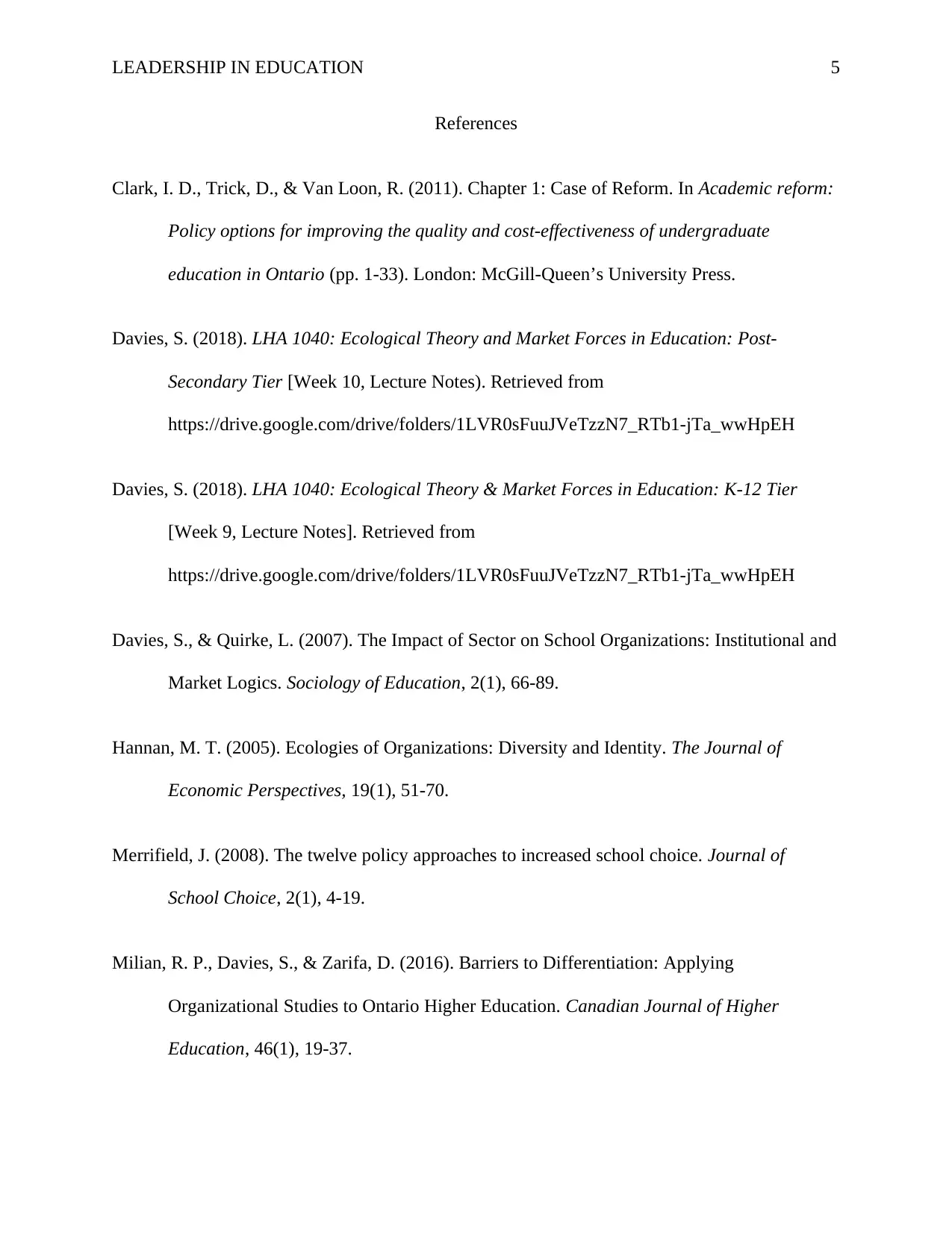
LEADERSHIP IN EDUCATION 5
References
Clark, I. D., Trick, D., & Van Loon, R. (2011). Chapter 1: Case of Reform. In Academic reform:
Policy options for improving the quality and cost-effectiveness of undergraduate
education in Ontario (pp. 1-33). London: McGill-Queen’s University Press.
Davies, S. (2018). LHA 1040: Ecological Theory and Market Forces in Education: Post-
Secondary Tier [Week 10, Lecture Notes). Retrieved from
https://drive.google.com/drive/folders/1LVR0sFuuJVeTzzN7_RTb1-jTa_wwHpEH
Davies, S. (2018). LHA 1040: Ecological Theory & Market Forces in Education: K-12 Tier
[Week 9, Lecture Notes]. Retrieved from
https://drive.google.com/drive/folders/1LVR0sFuuJVeTzzN7_RTb1-jTa_wwHpEH
Davies, S., & Quirke, L. (2007). The Impact of Sector on School Organizations: Institutional and
Market Logics. Sociology of Education, 2(1), 66-89.
Hannan, M. T. (2005). Ecologies of Organizations: Diversity and Identity. The Journal of
Economic Perspectives, 19(1), 51-70.
Merrifield, J. (2008). The twelve policy approaches to increased school choice. Journal of
School Choice, 2(1), 4-19.
Milian, R. P., Davies, S., & Zarifa, D. (2016). Barriers to Differentiation: Applying
Organizational Studies to Ontario Higher Education. Canadian Journal of Higher
Education, 46(1), 19-37.
References
Clark, I. D., Trick, D., & Van Loon, R. (2011). Chapter 1: Case of Reform. In Academic reform:
Policy options for improving the quality and cost-effectiveness of undergraduate
education in Ontario (pp. 1-33). London: McGill-Queen’s University Press.
Davies, S. (2018). LHA 1040: Ecological Theory and Market Forces in Education: Post-
Secondary Tier [Week 10, Lecture Notes). Retrieved from
https://drive.google.com/drive/folders/1LVR0sFuuJVeTzzN7_RTb1-jTa_wwHpEH
Davies, S. (2018). LHA 1040: Ecological Theory & Market Forces in Education: K-12 Tier
[Week 9, Lecture Notes]. Retrieved from
https://drive.google.com/drive/folders/1LVR0sFuuJVeTzzN7_RTb1-jTa_wwHpEH
Davies, S., & Quirke, L. (2007). The Impact of Sector on School Organizations: Institutional and
Market Logics. Sociology of Education, 2(1), 66-89.
Hannan, M. T. (2005). Ecologies of Organizations: Diversity and Identity. The Journal of
Economic Perspectives, 19(1), 51-70.
Merrifield, J. (2008). The twelve policy approaches to increased school choice. Journal of
School Choice, 2(1), 4-19.
Milian, R. P., Davies, S., & Zarifa, D. (2016). Barriers to Differentiation: Applying
Organizational Studies to Ontario Higher Education. Canadian Journal of Higher
Education, 46(1), 19-37.
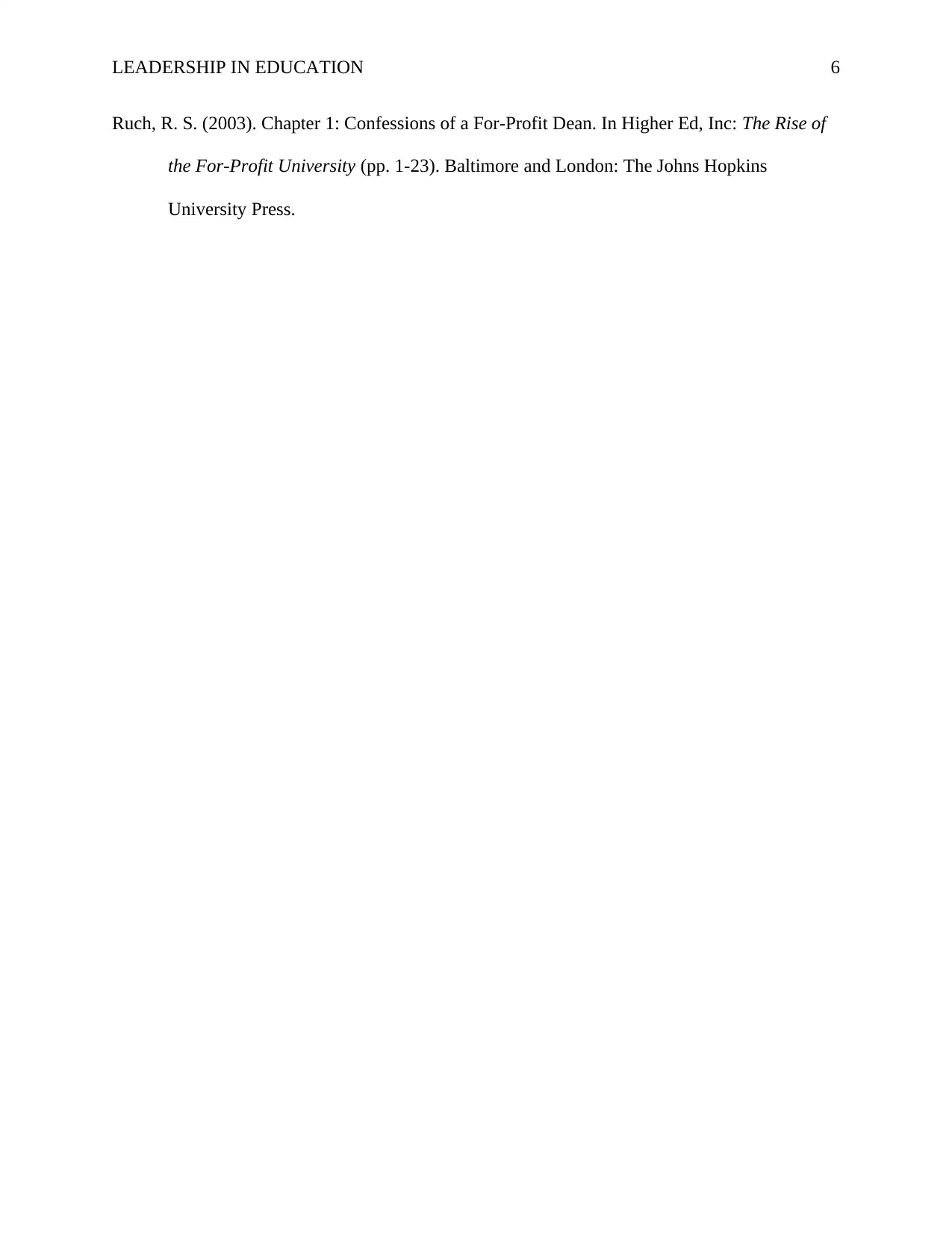
LEADERSHIP IN EDUCATION 6
Ruch, R. S. (2003). Chapter 1: Confessions of a For-Profit Dean. In Higher Ed, Inc: The Rise of
the For-Profit University (pp. 1-23). Baltimore and London: The Johns Hopkins
University Press.
Ruch, R. S. (2003). Chapter 1: Confessions of a For-Profit Dean. In Higher Ed, Inc: The Rise of
the For-Profit University (pp. 1-23). Baltimore and London: The Johns Hopkins
University Press.
⊘ This is a preview!⊘
Do you want full access?
Subscribe today to unlock all pages.

Trusted by 1+ million students worldwide
1 out of 6
Your All-in-One AI-Powered Toolkit for Academic Success.
+13062052269
info@desklib.com
Available 24*7 on WhatsApp / Email
![[object Object]](/_next/static/media/star-bottom.7253800d.svg)
Unlock your academic potential
Copyright © 2020–2025 A2Z Services. All Rights Reserved. Developed and managed by ZUCOL.